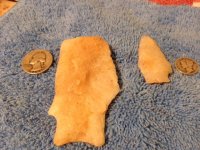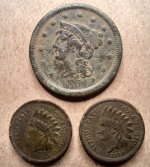gilmerman
Hero Member
On september 24th Tdog posted a picture of a chunk of yellow quartzite. Speculations were made about the workability of this material. It was felt that it could be worked and I agree, as I have several artifacts made of this material. They are not very sharp and hardly ever have I found a complete undamaged item. It would seem that there could have been a shortage of knappable material when these were made. Here is a photo of two of the best I have. Very easily broken. Can't speak to it always being yellow.


Upvote
0





